International barcoders get into print
Friday, February 26th, 2010
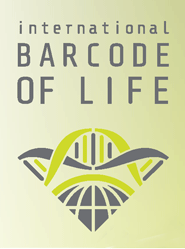 Now that 3rd International Barcode of Life Conference (held in November 2009 in Mexico City with over 350 researchers from 54 countries) is behind us, where to turn for DNA barcode science and organizational news? A bright answer arrived in today’s email: the first issue of the International Barcode of Life (iBOL) Bulletin (download pdf or view online flash version). The 12-page illustrated quarterly iBOL newsletter has a promising diversity of news. To take one example, I learned that some members of the North American Moth Photographers Group (MPG) are submitting their hard-to-identify specimens to Biodiversity Institute of Ontario, thus building up the reference library, and in turn receiving DNA-based identifications! This sort of crowd-sourcing approach to specimen collection could be a big thing for barcoding in particular, and for biodiversity science in general. There are many dedicated, expert, non-professionals who are likely to contribute given the right framework.
Now that 3rd International Barcode of Life Conference (held in November 2009 in Mexico City with over 350 researchers from 54 countries) is behind us, where to turn for DNA barcode science and organizational news? A bright answer arrived in today’s email: the first issue of the International Barcode of Life (iBOL) Bulletin (download pdf or view online flash version). The 12-page illustrated quarterly iBOL newsletter has a promising diversity of news. To take one example, I learned that some members of the North American Moth Photographers Group (MPG) are submitting their hard-to-identify specimens to Biodiversity Institute of Ontario, thus building up the reference library, and in turn receiving DNA-based identifications! This sort of crowd-sourcing approach to specimen collection could be a big thing for barcoding in particular, and for biodiversity science in general. There are many dedicated, expert, non-professionals who are likely to contribute given the right framework.
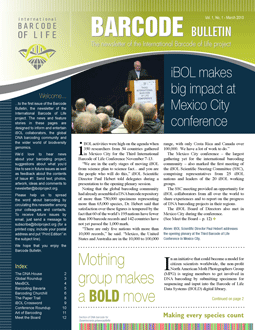 In terms of citizen participation, the MPG story suggests expanding opportunities for biological research that harnesses the skill and energy of non-professionals, a step beyond the successful BioBlitz model, which still requires a lot of on-site organization. If North American birders can create a comprehensive, regularly-updated database documenting migration, i.e. eBird (1 1/2 to 2 million sightings submitted monthly), then there must be a large potential for crowd-sourcing specimen collection, at least for certain organisms. After all, the most expensive part of biodiversity science is often collecting and/or documenting specimens. How to encourage and streamline data collection is suggested by Cornell University’s recently-released iPhone app BirdsEye, which displays current local sightings based on eBird database and user’s GPS location, with planned update that will enable birders to instantly update eBird with their own sightings.
In terms of citizen participation, the MPG story suggests expanding opportunities for biological research that harnesses the skill and energy of non-professionals, a step beyond the successful BioBlitz model, which still requires a lot of on-site organization. If North American birders can create a comprehensive, regularly-updated database documenting migration, i.e. eBird (1 1/2 to 2 million sightings submitted monthly), then there must be a large potential for crowd-sourcing specimen collection, at least for certain organisms. After all, the most expensive part of biodiversity science is often collecting and/or documenting specimens. How to encourage and streamline data collection is suggested by Cornell University’s recently-released iPhone app BirdsEye, which displays current local sightings based on eBird database and user’s GPS location, with planned update that will enable birders to instantly update eBird with their own sightings.
The Barcode Bulletin aims to “inform and entertain iBOL collaborators, the global DNA barcoding community and the wider world of biodiversity genomics”; this issue is a promising start.
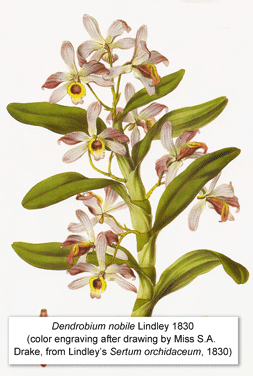 Herbal products make a compelling case for DNA-based identification–how else to recognize dried bits of roots, leaves, stems, bark, and flowers from a multitude of species? In
Herbal products make a compelling case for DNA-based identification–how else to recognize dried bits of roots, leaves, stems, bark, and flowers from a multitude of species? In 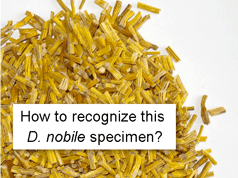 This study demonstrates advantages of DNA barcoding approach for plant identification. Of course, there is already a lot of interest in DNA identification of herbal plants in general and Dendrobium orchids in particular. For example, I found over a dozen articles describing DNA methods for distinguishing Dendrobium sp. However, the methods described are limited to identifying species in this one genus, which means one has to have a pretty good idea what the specimen is before applying DNA testing! This highlights the essential advantage of barcoding–a standardized approach can be applied to any unknown, and makes feasible creation of a comprehensive reference library.
This study demonstrates advantages of DNA barcoding approach for plant identification. Of course, there is already a lot of interest in DNA identification of herbal plants in general and Dendrobium orchids in particular. For example, I found over a dozen articles describing DNA methods for distinguishing Dendrobium sp. However, the methods described are limited to identifying species in this one genus, which means one has to have a pretty good idea what the specimen is before applying DNA testing! This highlights the essential advantage of barcoding–a standardized approach can be applied to any unknown, and makes feasible creation of a comprehensive reference library.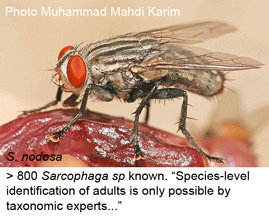 In forensic investigation, insect evidence helps date the time of death, as the various species that colonize corpses exhibit different stages of development according to time and temperature. Determining the post-mortem interval (PMI) rests on accurate species identification, including of immature forms. In
In forensic investigation, insect evidence helps date the time of death, as the various species that colonize corpses exhibit different stages of development according to time and temperature. Determining the post-mortem interval (PMI) rests on accurate species identification, including of immature forms. In